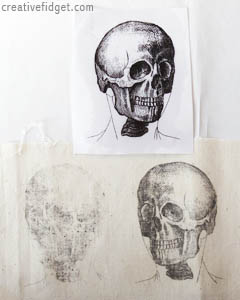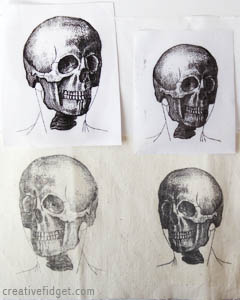The sorts of embroidery designs I have in my head require a better way to transfer an image onto fabric than chalk or a transfer pen, so I’ve been doing a bit of research.
First I found a tutorial for ironing a laser print onto fabric. I tried it for the minis but got a very faint image and had to go over it in pencil.
Exploring further, I found plenty of mentions of iron-on transfer sheets that can be used with inkjet printers, but they tend to leave a film over the fabric. I already knew you could use gel medium to transfer laser prints, but figured the medium would stiffen up the fabric.
For laser printers I found a method for laser printing onto fabric by fusing it to freezer paper first, but I’m a little reluctant to do that to my laser printer.
Then I found a YouTube tutorial for transferring laser prints to fabric using Citro Solve. As I expected Citro Solve isn’t available in Australia, but it turns out that any citrus based cleaner works. However, with supermarkets reducing their product range we’d already been having trouble finding our favourite one, Orange Power. I eventually found Citro Clean at an IGA thanks to a tip in a scrapbooking forum.
My test of the Citro Clean worked brilliantly, except there was a blue stain rather like bleeding ink around the lines. This didn’t make any sense – toner doesn’t contain ink. I tried washing it out, but the stain stayed and the toner began to come off, so I figured the citrus cleaner wasn’t going to work out.
So I looked for another method. I found a tutorial using a ‘colourless blender’ pen. The brand wasn’t available in Australia, of course, but Copic markers are and they have one.
Then I found a tutorial for making your own blender pen using isopropyl alcohol, glycerine and distilled water. I was all set to venture out and buy the ingredients when I realised why the Citro Clean test hadn’t worked. I’d put a Lincraft bag under the fabric in case the cleaner affected my work table. The blue had come off the bag. Sigh. So I tried again.
For my artwork I photographed some royalty-free anatomical/medical etchings, enlarged and printed them so the linework was visible. For fabric I used good old calico.

Following the tutorial above, I placed the printout face down, sprayed the back and rubbed it all over using a plastic bone folder. The first one (on the right) did not work so well, though there were no blue stains this time. I figured the print had moved so tried again with a bit more Citro Clean. It worked better. Much better. More than moving the print could explain.

So I tried the next test print. As before, the first transfer was fainter and the second was much better.

Perhaps this was because the artwork was printed the day before. Maybe the Citro Clean needed time to soften up the toner. So I did a third test. This time I sprayed the front of the artwork and gave it a few minutes to ‘soften up’.

Then, while it was still wet, I placed it face down and rubbed the back no more or less than the first tests. It came out even darker and clearer.

So I have a successful and cheap way of transferring images! Yay! I’m going to use the two best test pieces here to see if I like embroidering over old etchings. If I do… well, I have plenty more where they came from.
My method of last resort was Spoonflower. But that requires planning and patience. It’d be more economical to have several designs printed at a time, too, which would mean waiting until I’d gathered a collection together before having them printed. Big designs would be hard to mange using the citrus cleaner method, too.

Back when I was painting clothes, I would make copies of my patterns on a Xerox machine and then just iron them onto the fabric. Since I was only using an outline and no shading or detail in my pattern, this would work fine. I’d do all the shading and detail with the paint.